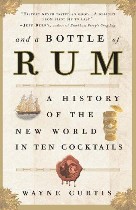 Wayne Curtis •
Wayne Curtis •
And a Bottle of Rum •
It’s possible to read this book from cover to cover without ever lifting a glass to your lips, but why would you want to? As master wordsmith Wayne Curtis traces the unsavory, turbulent, and occasionally shocking path of his preferred drink, you’re bound to get thirsty.
The book begins at the City Tavern Restaurant in Philadelphia, known for its colonial atmosphere, and ends with a bevy of cocktail recipes including planter’s punch and the Mary Pickford. Along the way you learn about grog and kill-devil, daiquiris and mojitos, and discover that the Triangle Trade you were taught in grade school, consisting of rum-slaves-molasses, New England to Africa to the West Indies, was largely a convenient fabrication. According to Curtis, there is no record that any ship ever made such a voyage, and besides, “More molasses went into pudding, beer making, and baked beans than into rum for the slave trade.”
The Captain Morgan who now graces rum bottle labels was real enough, and frightening enough, even if he never drank the stuff. But, says Curtis, “Rum has learned to work with whatever history gives it.” Gentleman’s quaff or demon spirit, rum has been in the thick of drinking parties, and drinking controversies, for well over 300 years. This may be its most comprehensive biography to date—even though “learning about rum at the City Tavern, it turns out, was like learning about the habits of wild bears at Walt Disney World’s Country Bear Jamboree.”
It’s safe to assume the author did a bit of tippling himself while researching this 150-proof topic. His acknowledgements end with an apology to everyone he may have forgotten to mention, “for reasons too obvious to explain.”







Your email address will not be published.